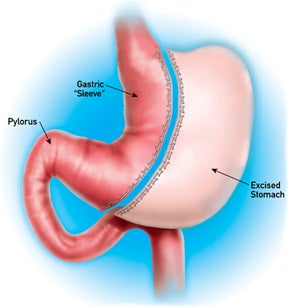
With the sleeve gastrectomy or gastric sleeve, your stomach will be made smaller by stapling and dividing the majority of your stomach and removing it from your body. The remaining stomach is shaped like a long narrow tube with a small reservoir for food at the end of the tube. This reservoir only holds about 3 ounces of food, meaning you will feel full more quickly after your gastric sleeve and therefore lose weight.
The sleeve gastrectomy retains the normal valve (pylorus) that allows food to exit your stomach. Because of this, the stomach is able to move food into the small intestines at a normal rate, which avoids the dumping syndrome that is common with the gastric bypass procedure. Additionally, the acids and digestive enzymes that help absorb vitamins and minerals are not bypassed during a gastric sleeve, which places you at lower risk for vitamin deficiencies. However, since your stomach is smaller, it will absorb these substances less efficiently, so you will still need to take vitamin replacements.
As you begin to eat and take medications, there will be some swelling of the tube that makes it difficult for any solid food to pass. As a guideline, food should be able to pass through a straw, which is why you are placed on a special liquid diet immediately following gastric sleeve surgery. The goal is to let the stomach heal; only liquids and soft solids should be eaten during the first six weeks. Since many pills are quite large and will not fit through the tube, we ask you to crush all medications or take them in liquid or chewable form. You will receive written instructions on the proper diet to follow from your dietitian.
